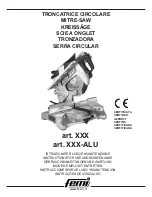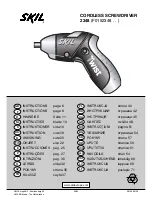
1) Kickback is a sudden reaction to a pinched, bound
or misaligned saw blade, causing an uncontrolled
saw to lift up and out of the workpiece toward the
operator.
2) When the blade is pinched or bound tightly by the
kerf closing down, the blade stalls and the motor
reaction drives the unit rapidly back toward the
operator.
3) If the blade becomes twisted or misaligned in the
cut, the teeth at the back edge of the blade can dig
into the top surface of the wood causing the blade
to climb out of the kerf and jump back toward the
operator.
4) Kickback is the result of tool misuse and/or incorrect
operating procedures or conditions and can be
avoided by taking proper precautions.
Maintain a
firm grip with both hands on the saw and
position your body and arm to allow you to
resist KICKBACK forces.
KICKBACK forces can be controlled by the operator,
if proper precautions are taken.
Causes and prevention of KICKBACK:
Specific rules for battery and charger
1.
To charge your battery, use only the charger
provided with your tool.
Do not substitute any
other charger.
2.
Do not disassemble charger or operate the charger
if it has received a sharp blow, been dropped or
otherwise damaged in any way.
Replace damaged
15.
This circular saw should not be mounted to a
table and converted to a table saw.
Circular saw
are not designed or intended to be used as table saws.
16.
When blade is binding, or when interrupting a cut
for any reason, release the trigger and hold the
saw motionless in the material until the blad
e
comes to a complete stop. Never attempt to
remove the saw from the work or pull the saw
backward while the blade is in motion or
KICKBACK may occur.
Investigate and take
corrective action to eliminate the cause of blade
binding. Wet lumber, green lumber or
pressure-treated lumber require special attention
during cutting operation to prevent KICKBACK.
Avoid cutting nails. Inspect for and remove all nails
from lumber before cutting.
KICKBACK
17.
When restarting a saw in a workpiece, center the
saw blade in the kerf and check that saw teeth
are not engaged into the material.
If saw blade is
binding, it may walk up or KICKBACK from the
workpiece as the saw is restarted.
18.
Do not use a dull or damaged blade.
Unsharpened
or improperly set blades will produce a narrow kerf,
causing excessive friction, blade binding and
KICKBACK.
19.
Blade depth and bevel adjusting locking knobs
must be tight and secure before making cut.
If
blade adjustment shifts while cutting, it may cause
binding and KICKBACK. Using the saw with an
excessive depth of cut setting increases loading on
the unit and susceptibility to twisting of the blade in
the kerf. It also increases the surface area of the
blade available for pinching under conditions fo kerf
close down.
20.
Use extra caution when making a “Pocket Cut”
into existing walls or other blind areas.
The
protruding blade may cut objects that can cause
KICKBACK.
WARNING:
Some dust created by power sanding, sawing,
grinding, drilling, and other construction activities contains
chemicals known to cause many serious diseases such
as cancer. Some examples of these chemicals are:
1. Lead from lead-based paints,
2. Crystalline silica from bricks and cement and other
masonry products
3. Arsenic and chromium from chemically-treated lumber.
Your risk from these exposures varies, depending on how
often you do this type of work. To reduce your exposure
to these chemicals: work in a well ventilated area, and
work with approved safety equipment, such as dust
masks specially designed to filter out microscopic
particles.
This product is intended to cut wood and
wood-like products only.
Dust build-up around the lower
guard and hub from other materials (masonry or metal)
may disable the lower guard operation.
ENGLISH
19






































